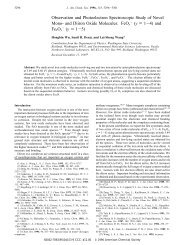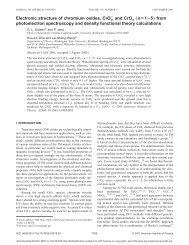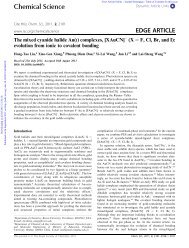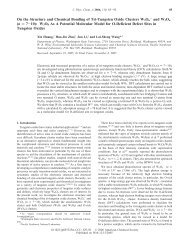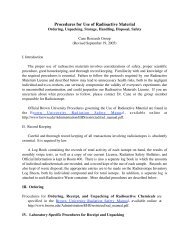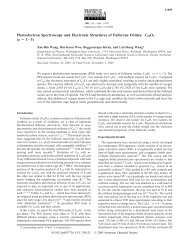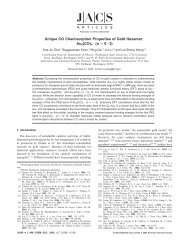A study of the structure and bonding of small aluminum oxide ...
A study of the structure and bonding of small aluminum oxide ...
A study of the structure and bonding of small aluminum oxide ...
Create successful ePaper yourself
Turn your PDF publications into a flip-book with our unique Google optimized e-Paper software.
Desai et al.: Aluminum <strong>oxide</strong> clusters<br />
1313<br />
expected. For Al 2 O 2 , <strong>the</strong>re is an excess <strong>of</strong> valence electrons,<br />
<strong>and</strong> <strong>the</strong>refore, a low EA <strong>and</strong> low-lying exited states are expected.<br />
In Al 2 O 3 , which is <strong>of</strong> <strong>the</strong> same stoichiometry as in<br />
<strong>the</strong> bulk <strong>oxide</strong>, <strong>the</strong> valences <strong>of</strong> both <strong>the</strong> Al <strong>and</strong> O atoms are<br />
saturated. This is expected to result in a closed shell molecule<br />
with a significant gap between its highest occupied<br />
molecular orbital HOMO <strong>and</strong> lowest unoccupied molecular<br />
orbital LUMO. This gap is directly accessible from <strong>the</strong><br />
anion PES spectrum. The higher Al 2 O y clusters have excess<br />
O atoms <strong>and</strong> are electron deficient. They are expected to<br />
have high EAs. The experimental observations from <strong>the</strong> PES<br />
spectra are consistent with this general view. In <strong>the</strong> following,<br />
each cluster is discussed in detail.<br />
A. AlO <br />
The photoelectron spectrum <strong>of</strong> AlO at 6.42 eV detachment<br />
energy is shown in Fig. 1a. The X <strong>and</strong> A b<strong>and</strong>s have<br />
been observed before at lower photon energies, which<br />
yielded much better resolved spectra. 52 We will emphasize<br />
<strong>the</strong> new feature observed at high BE B 2 . As mentioned<br />
above, <strong>the</strong> valence configuration for AlO can be written as<br />
2 2 1 4 3 1 . In <strong>the</strong> anion, <strong>the</strong> extra electron enters <strong>the</strong> 3<br />
orbital, giving a closed-shell ground state with a configuration<br />
<strong>of</strong> 2 2 1 4 3 2 X 1 . The first feature, at 2.60 eV, corresponds<br />
to <strong>the</strong> removal <strong>of</strong> an electron from <strong>the</strong> 3 orbital,<br />
yielding <strong>the</strong> X 2 ground state <strong>of</strong> <strong>the</strong> neutral AlO. The second<br />
feature, at 3.26 eV, corresponds to <strong>the</strong> removal <strong>of</strong> a 1<br />
electron to give <strong>the</strong> A 2 excited state <strong>of</strong> AlO.<br />
The third feature at 5.19 eV <strong>the</strong>n must be due to <strong>the</strong><br />
removal <strong>of</strong> a 2 electron to give <strong>the</strong> B 2 excited state <strong>of</strong><br />
AlO. The excitation energy <strong>of</strong> this state relative to <strong>the</strong><br />
ground state is 2.59 eV, which is in excellent agreement with<br />
<strong>the</strong> available literature value 38 for this excited state. Therefore,<br />
<strong>the</strong> spectrum shown in Fig. 1a reveals <strong>the</strong> full valence<br />
MOs <strong>of</strong> <strong>the</strong> AlO molecule. However, it is surprising that<br />
little vibrational excitation is observed for <strong>the</strong> B 2 state,<br />
suggesting that <strong>the</strong> 2 orbital is ra<strong>the</strong>r non<strong>bonding</strong>. This is<br />
contrary to <strong>the</strong> expectation <strong>of</strong> simple MO arguments, that <strong>the</strong><br />
2 orbital should be a strongly <strong>bonding</strong> MO representing <strong>the</strong><br />
Al–O bond.<br />
B. AlO 2<br />
<br />
Matrix isolation experiments suggested <strong>the</strong> existence <strong>of</strong><br />
two isomers for this molecule; one is a symmetric linear<br />
molecule <strong>and</strong> <strong>the</strong> o<strong>the</strong>r is a complex <strong>of</strong> an <strong>aluminum</strong> atom<br />
with an oxygen molecule. 13 Calculations have found that <strong>the</strong><br />
two isomers are almost isoenergetic with <strong>the</strong> linear molecule<br />
being <strong>the</strong> global minimum. 54 Our previous work with <strong>the</strong><br />
vibrationally resolved ground state (X), at a photon energy<br />
<strong>of</strong> 4.66 eV, has established that <strong>the</strong> AlO 2 anion produced in<br />
our laser vaporization source was <strong>the</strong> symmetric linear one<br />
without any indication <strong>of</strong> a second isomer. 52 The very high<br />
EA <strong>of</strong> AlO 2 compared to AlO was already revealed. Figure<br />
1b shows two more new features, which should be due to<br />
<strong>the</strong> excited states <strong>of</strong> <strong>the</strong> linear OAlO molecule.<br />
The valence electronic configuration <strong>of</strong> AlO 2 can be<br />
written as 4 2 g 1 4 3<br />
u 2 g <strong>and</strong> that <strong>of</strong> <strong>the</strong> anion as<br />
4 g 2 1 u 4 2 g 4 . 70 Therefore, <strong>the</strong> first feature, at 4.23 eV, is<br />
attributed to <strong>the</strong> removal <strong>of</strong> a 2 g electron resulting in <strong>the</strong><br />
2 g ground state <strong>of</strong> AlO 2 . The peak at 4.88 eV is attributed<br />
to <strong>the</strong> removal <strong>of</strong> a 1 u electron to give <strong>the</strong> A 2 u excited<br />
state <strong>of</strong> AlO 2 . It has an excitation energy <strong>of</strong> 0.65 eV relative<br />
to <strong>the</strong> ground state. A vibrational frequency <strong>of</strong> 810 60<br />
cm 1 is obtained for <strong>the</strong> A 2 u state. The third peak<br />
(B 2 g ) at 5.08 eV is due to <strong>the</strong> removal <strong>of</strong> a 4 g electron.<br />
This state has an excitation energy <strong>of</strong> 0.85 eV relative to <strong>the</strong><br />
ground state. Both <strong>the</strong> A 2 u <strong>and</strong> B 2 g excited states <strong>of</strong><br />
AlO 2 have never been experimentally observed before.<br />
C. Al 2 O 2<br />
<br />
Figures 2, 3a, <strong>and</strong> 3b show photoelectron spectra for<br />
Al 2 O 2 at 532 <strong>and</strong> 355, 266, <strong>and</strong> 193 nm, respectively. All<br />
<strong>the</strong> high photon energy spectra are consistent with those obtained<br />
at lower photon energies. The spectrum at 532 nm<br />
shows a sharp peak at 1.88 eV followed by a vibrational<br />
progression with a frequency <strong>of</strong> 660 80 cm 1 . The spectrum<br />
at 355 nm reveals a second b<strong>and</strong> at 2.37 eV, which also<br />
contains a vibrational progression. The second b<strong>and</strong> has a<br />
similar Franck–Condon envelope as <strong>the</strong> first b<strong>and</strong>, with a<br />
similar vibrational frequency 730 80 cm 1 . The spectrum<br />
at 266 nm does not show any new features, while a new<br />
feature is observed at 193 nm <strong>and</strong> at a much higher BE <strong>of</strong><br />
about 5.1 eV. The first peak corresponds to <strong>the</strong> ground state<br />
<strong>of</strong> <strong>the</strong> neutral molecule, whose EA is measured to be 1.88<br />
eV. The second peak is due to <strong>the</strong> first excited state <strong>of</strong> Al 2 O 2<br />
with an excitation energy <strong>of</strong> 0.49 eV relative to <strong>the</strong> ground<br />
state. The third b<strong>and</strong>, well separated from <strong>the</strong> first two b<strong>and</strong>s<br />
<strong>and</strong> only observed at 193 nm, belongs to <strong>the</strong> second excited<br />
state <strong>of</strong> <strong>the</strong> molecule.<br />
Several matrix isolation experiments have been performed<br />
on Al 2 O 2 . 6,7,10,11,13,18 However, <strong>the</strong>re have been noticeable<br />
disagreements in <strong>the</strong> assignment <strong>of</strong> <strong>the</strong> observed infrared<br />
b<strong>and</strong>s to <strong>the</strong> most energetically favored <strong>structure</strong>,<br />
which is a cyclic D 2h molecule, as determined by several<br />
<strong>the</strong>oretical calculations. 58–63 Figure 4a shows a schematic<br />
<strong>of</strong> this <strong>structure</strong>. Although <strong>the</strong>re have been some experimental<br />
studies that have ei<strong>the</strong>r discounted <strong>the</strong> existence <strong>of</strong> <strong>the</strong><br />
D 2h isomer in <strong>the</strong> matrix 18 or have proposed alternative<br />
<strong>structure</strong>s for Al 2 O 2 , 10 several <strong>the</strong>oretical calculations have<br />
shown quite convincingly that <strong>the</strong> D 2h <strong>structure</strong> corresponds<br />
to <strong>the</strong> global minimum on <strong>the</strong> total potential energy<br />
surface. 58–63<br />
Semiempirical <strong>and</strong> ab initio calculations performed on<br />
Al 2 O 2 suggested that <strong>the</strong>re were two stable isomers, one was<br />
a square cyclic <strong>structure</strong> (D 2h ) with an AlO optimized bond<br />
length <strong>of</strong> 1.7 Å <strong>and</strong> <strong>the</strong> o<strong>the</strong>r was a linear configuration<br />
which was less stable than <strong>the</strong> cyclic <strong>structure</strong> by 0.65 eV. 59<br />
Later calculations using SCF <strong>and</strong> MP2 methods determined<br />
that <strong>the</strong>re are two minima, one almost square <strong>and</strong> <strong>the</strong> o<strong>the</strong>r a<br />
rhombus, both with a D 2h symmetry <strong>and</strong> a 1 A g ground<br />
state. 58,60,61,63 More recent calculations have shown that <strong>the</strong><br />
singlet D 2h rhombus <strong>structure</strong> is <strong>the</strong> global minimum <strong>and</strong><br />
that <strong>the</strong> previous spectroscopic identification <strong>of</strong> two rhombic<br />
isomers <strong>of</strong> Al 2 O 2 should be attributed to <strong>the</strong> 1 A g ground state<br />
J. Chem. Phys., Vol. 106, No. 4, 22 January 1997<br />
Downloaded¬26¬Jun¬2007¬to¬130.20.226.164.¬Redistribution¬subject¬to¬AIP¬license¬or¬copyright,¬see¬http://jcp.aip.org/jcp/copyright.jsp



